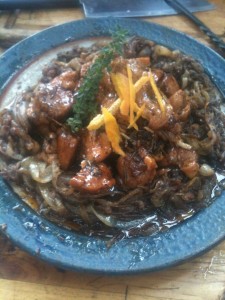During Love and Romance weekend, we did another recipe – Coq Au Vin and Spanish Spiced Onions. Now some would argue the two dishes would not work well together, but we found a happy compromise. Instead of traditional wine, we used a mead that is sold at the Minnesota Renaissance Festival, not far from our stage. The taste was lighter than most Coq Au Vin recipes.
Now, Coq au Vin is traditionally made with rooster but those are difficult to come by in the 21st century, so we used chicken. This dish has been simplified for our use and modern palates, but I am sure that you will like it.
COQ AU VIN
Ingredients:
2 lbs. of chicken breasts, cut up to one each pieces.
6 cups of mead or sweet wine
1/2 lb bacon, minced
2 cloves of garlic, minced
1/2 cup of chives, minced
1/2 cup thyme
1/4 cup of rosemary
1 tsp of orange zest
salt and pepper to taste
Begin by cooking the bacon on medium heat. Once the fat has rendered and the bacon has begun to cook, add the chicken to brown and add the garlic. Once the chicken is thoroughly browned, add the mead and the herbs to the dish, holding off on the salt and pepper until the end. Cover the dish and stir occassionally (every 5 – 7 minutes) until the chicken is done and pull off of the heat.
SPANISH SPICED ONIONS
Ingredients:
3 lbs. of onions, sliced
4 Tbsp of butter
4 Tbsp of olive oil
1 tsp of minced garlic
1 tsp of thyme
1/2 tsp of cayenne pepper
1/2 tsp of salt
1/2 tsp of fresh ground pepper
Heat the oil and butter together and add the spices and herbs. Keep stiring and slowly add the onions. Stir continuously until the onions are thoroughly sweated and are translucent. They should not be crisp.
Scoop the Coq au Vin onto the plate and surround with the Spanish Spiced Onions. Serves 2-4.




